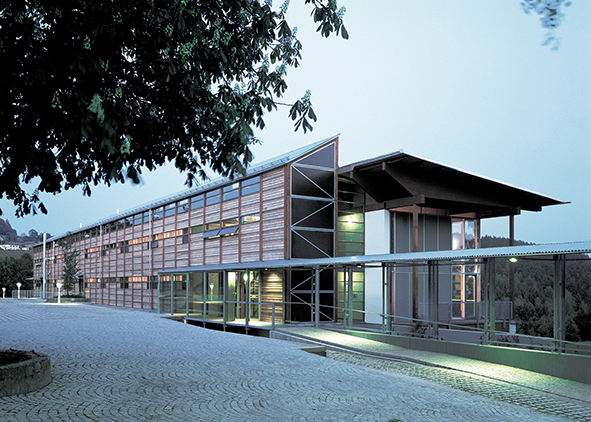On flexible and green design. Perspectives and personal reflections
DOI:
https://doi.org/10.19229/2464-9309/822020Keywords:
zoning, flexibility, performance form, green facades, biophiliaAbstract
The majority of humanity will live in megacities in the future. The world’s major cities recognise the connection between quality of life and green spaces. Green facades affect many parameters of a building, but human ‘biophilia’ is currently rarely a planning goal. While the effects of vegetation on the building climate can be of great importance, the potential sensory impact on the person inside needs to be taken into consideration as a subsystem in the buildings of the future. Architecture deals with the spirit of a place and with artefacts that relate to it. A characteristic of this is thinking in the different levels of the subsystems, cycles and time phases. Considering changes in the use and function of the built space while focusing on sustainable construction and renewable energies creates the chance of a performance-form of a performance-form of a specific architectural quality.
Downloads
Article Metrics Graph
References
Arup (2016), Cities Alive – Green Building Envelope. [Online] Available at: www.arup.com/perspectives/publications/research/section/cities-alive-green-building-envelope [Accessed 14 November 2020].
Bratman, G. N., Hamilton, J. P. and Daily, G. C. (2012), “The impacts of nature experience on human cognitive function and mental health”, in Annals of the New York Academy of Sciences, vol. 1249, issue 1, pp. 118-136. [Online] Available at: doi.org/10.1111/j.1749-6632.2011.06400.x [Accessed 14 November 2020].
Brod, C. (1984), Technostress – The human cost of computer revolution, Addison-Wesley, Reading.
Cytowic, R. E. and Eagleman, D. M. (2009), Wednesday is indigo blue – Discovering the brain of synesthesia, MIT Press, Cambridge-London.
Fromm, E. (1973), The anatomy of human destructiveness, Fawcett, New York.
Gobster, P. H., Nassauer, J. I., Daniel, T. C. and Fry, G. (2007), “The shared landscape – What does aesthetics have to do with ecology?”, in Landscape Ecology, vol. 22, issue 7, pp. 959-972. [Online] Available at: doi.org/10.1007/s10980-007-9110-x [Accessed 14 November 2020].
Herzog, T. (1992), Thomas Herzog – Bauten, 1978-1992 – Ein Werkbericht | Buildings, 1978-1992 – A working report, G. Hatje, Stuttgart.
Herzog, T., Flagge, I., Herzog-Loibl, V. and Meseure, A. (2002), Thomas Herzog – Architektur + Technologie | Architecture + Technology, Prestel, Munchen-New York.
Kaplan, R. and Kaplan, S. (2011), “Well-being, Reasonableness, and the Natural Environment”, in Applied Psychology – Health and Well-Being, vol. 3, issue 3, pp. 304-321. [Online] Available at: doi.org/10.1111/j.1758-0854.2011.01055.x [Accessed 14 November 2020].
Kaplan, R. and Kaplan, S. (1989), The experience of nature – A psychological perspective, Cambridge University Press, Cambridge-New York.
Kuo, F. E. and Sullivan, W. C. (2001), “Aggression and Violence in the Inner City – Effects of Environment via Mental Fatigue”, in Environment and Behavior, vol. 33, issue 4, pp. 543-571. [Online] Available at: doi.org/10.1177/00139160121973124 [Accessed 14 November 2020].
Kuo, M. (2015), “How might contact with nature promote human health? Promising mechanisms and a possible central pathway”, in Frontiers in Psychology, vol. 6, article 1093. [Online] Available at: doi.org/10.3389/fpsyg.2015.01093 [Accessed 14 November 2020].
Louv, R. (2008), Last child in the woods – Saving our children from nature-deficit disorder, Algonquin Books of Chapel Hill, Chapel Hill (NC).
Miyazaki, Y. (2018), Shinrin-yoku – La teoria giapponese del bagno nella foresta per ritrovare il proprio equilibrio, Gribaudo, Milano.
Pallasmaa, J. (2012), The eyes of the skin – Architecture and the senses, Wiley, Chichester
Pauli, M. and Scheuermann, R. (2017), “Messbare Vorteile von Fassadenbegrünungen | Measurable benefits of green facades”, in Detail, vol. 01/2017, pp. 48-55. [Online] Available at: issuu.com/detail-magazine/docs/bk_green_2017-1-det-dee/8 [Accessed 14 November 2020].
Taylor, A. F., Kuo, F. E. and Sullivan, W. C. (2002), “Views of Nature and Self-discipline – Evidence from inner city children”, in Journal of Environmental Psychology, vol. 22, issues 1-2, pp. 49-63. [Online] Available at: doi.org/10.1006/jevp.2001.0241 [Accessed 14 November 2020].
Teilhard de Chardin, P. (1959), The phenomenon of man [or. ed. Le phénomène humain, 1955], Harper and Row Publisher, New York. [Online] Available at: collopy.net/teaching/2017/evolution/readings/The%20 Phenomenon%20of%20Man.pdf [Accessed 14 November 2020].
Tennessen, C. M. and Cimprich, B. (1995), “Views to nature – Effects on attention”, in Journal of Environmental Psychology, vol. 15, issue 1, pp. 77-85. [Online] Available at: doi.org/10.1016/0272-4944(95)90016-0 [Accessed 14 November 2020].
Ulrich, R. S., Bogren, L. and Lundin, S. (2012), “Towards a design theory for reducing aggression in psychiatric facilities”, in ARCH12 – Architecture / Research / Care / Health Perspectives on Nordic Welfare Environments, Chalmers, Gothenburg, November 12-14, 2012, pp. 1-12. [Online] Available at: conferences.chalmers.se/index.php/ARCH/arch12/paper/view/426/67 [Accessed 14 November 2020].
UN – United Nations (2019), World Population Prospects 2019 – Highlights. [Online] Available at: population.un.org/wpp/Publications/Files/WPP2019_Highlights.pdf [Accessed 14 November 2020].
Wilson, E. O. (1984), Biophilia – The human bond with other species, Harvard University Press, Cambridge.

Downloads
Published
How to Cite
Issue
Section
License
This Journal is published under Creative Commons Attribution Licence 4.0 (CC-BY).
License scheme | Legal code
This License allows anyone to:
Share: copy and redistribute the material in any medium or format.
Adapt: remix, transform, and build upon the material for any purpose, even commercially.
Under the following terms
Attribution: Users must give appropriate credit, provide a link to the license, and indicate if changes were made; users may do so in any reasonable manner, but not in any way that suggests the licensor endorses them or their use.
No additional restrictions: Users may not apply legal terms or technological measures that legally restrict others from doing anything the license permits.
Notices
Users do not have to comply with the license for elements of the material in the public domain or where your use is permitted by an applicable exception or limitation.
No warranties are given. The license may not give users all of the permissions necessary for their intended use. For example, other rights such as publicity, privacy, or moral rights may limit how you use the material.


















































































